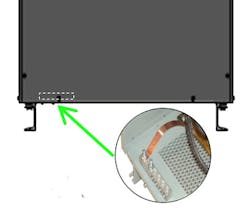Neutral Grounding of Dry-Type Ventilated Transformers
In the 2014 Edition of the National Electrical Code (NEC), a revision was made that seems to have gone largely unnoticed by manufacturers of ventilated dry-type transformers. Section 450.10(A) of the 2017 NEC requires a “terminal bar” for all grounding and bonding conductor connections. Doing an Internet search reveals that a few good articles addressed this change around 2014; however, there seems to be very little movement by the major manufacturers of dry-type transformers to provide the terminal bar. So this places the responsibility of providing the terminal bar on the shoulders of the installer.
For at least 100 years, electricians have been grounding dry-type transformers, and it always seems to be a struggle to do it with a method that meets Code requirements. This apparently was the driving force behind the proposal in the 2014 Code cycle (i.e, that a terminal bar be provided in ventilated dry-type transformers). Some of the more common methods that installers have been using in the past are:
1) Using the vent holes in the bottom of the enclosure to terminate mechanical or compression type lugs. (Note: This is a Code violation as Sec. 450.10 doesn’t allow you to do this.)
2) Using one large split-bolt connector with a threaded stud through either a drilled hole or a vent hole. (Note: This is typically ― at the very least ― a violation of the listing of the split bolt connector.)
3) Stacking D-lugs under a single bolt that is either inserted through a vent hole or a drilled hole. (Note: This may be acceptable to the authority having jurisdiction.), and
4) Installing a terminal bar in the bottom of the transformer as required by the Code.
Installing a terminal bar or a bus in the bottom of smaller dry-type transformers can be a challenge due to space limitations and avoiding the vent holes. For this reason, it would make more sense for the terminal bar ― or at least the means for a terminal bar ― to be provided by the transformer manufacturer in all cases. This, of course, would mean a change in product standards and the listing requirements for dry-type transformers.
Until the day arrives when this requirement is part of a product standard for all dry-type transformers, either purchase a transformer that includes the terminal bar, or check with the AHJ as to the grounding method that will be acceptable.
© 2018 Fluor Corporation. All Rights Reserved.
About the Author
Eddie Guidry
Senior Fellow
Eddie Guidry is a senior fellow with Fluor Enterprises, Inc., Sugar Land, Texas. He is highly skilled in electrical and control systems for industrial construction, design, and engineering (both domestic and abroad). The majority of Eddie’s 38 years of experience includes upstream and downstream portions of petrochemical plants and refineries. He is also heavily experienced in water and wastewater treatment facilities. Eddie is very active in the development of U.S. national (ANSI) and international codes and standards, and has been a principal member of the National Fire Protection Association (NFPA) National Electrical Code (NEC) committee since 1999 and NFPA’s National Advisory Committee on Electrical Safety Research since 2008. Eddie, who has also developed and conducted many electrical courses and seminars over the years, currently holds the corporate Master Electrician license for Fluor Corporation in the State of Texas and is also an ICC/IAEI certified electrical inspector.

